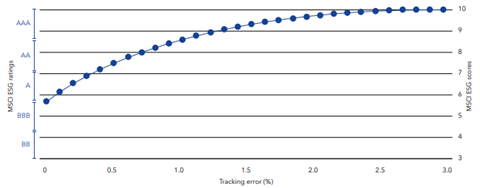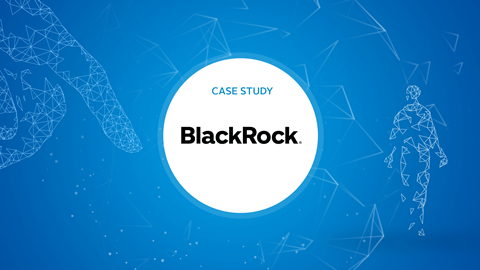- Signatory name: BlackRock
- Signatory type: Investment manager
- Operating region: Global
- Assets under management:$6.96 trillion (September 2019)
- Assets in passive/index strategies:$4.59 trillion (September 2019)
BlackRock believes environmental, social and governance (ESG) factors can have a material impact on financial performance, and we aspire to be a leader in how we incorporate sustainability across the firm.
Why create risk-based, ESG-optimised portfolios?
ESG optimisation can significantly improve a portfolio’s ESG rating while seeking to closely track a traditional benchmark such as the MSCI World. Compared with traditional ESG indices, risk-based ESG optimisation presents a more flexible approach for benchmark-aware investors.
In addition to targeting an overall ESG score, investors can target specific ESG-related objectives, such as reporting and reducing a portfolio’s carbon footprint. While targeting higher ESG scores generally leads to lower portfolio emissions in itself, the relationship between carbon emissions and overall ESG rating is not necessarily consistent, e.g. companies with low carbon emissions may have low overall ESG ratings due to corporate governance concerns.
We found that ESG optimisation can be used to help maximise a portfolio’s ESG rating and/or minimise a portfolio’s carbon footprint – within specific active risk constraints.
How we incorporate a carbon emission reduction target alongisde ESG ratings and risk
To investigate whether a portfolio’s ESG score can be improved without adding significant active risk (tracking error) relative to a standard equity market index, we draw on long-term, historical ESG ratings (2011-2017), carbon footprint data and financial data on hypothetical portfolio scenarios.
Figure 1: Trade-off between tracking error and ESG ratings/scores

The majority of the carbon reduction occurs within the first 60bps of tracking error relative to the MSCI World: with a tracking error of around 60bps, we believe it is possible to improve ESG ratings by two levels, from BBB to AA, as well as reduce carbon emissions from 195.72 metric tonnes to 158.22: a 19.16% reduction. Beyond that point, it takes nearly 200bps of additional tracking error before further significant carbon reduction is achieved.
In optimising for two factors, though, higher active risk is needed to achieve the same ESG ratings improvement when compared to a single ESG optimiser.
Figure 2: Trade-off between tracking error, ESG ratings and CO2 footprint

Not all indices can be optimised for the same ESG improvement while targeting a similar tracking error. For example, the MSCI Emerging Markets Index (MSCI EM) has an overall ESG rating of BB (November 2017 data). While a higher overall ESG rating may be achieved, this may materialise at a higher tracking error when compared to the developed market equivalent (MSCI World Index).
From a carbon perspective, our simulation suggests that a 30% reduction can be obtained with a tracking error of around 50bps for the MSCI EM. While it is possible to reduce emissions further with a higher tracking error, any potential benefits are significantly diminished relative to the additional risks taken. Compared to developed markets, the starting level of carbon emission is also much higher for the MSCI EM, and therefore, it is not possible to reach a similar level of emission reduction with a similar tracking error.
Figure 3: Optimisation trade-offs for EM MSCI and World – simulated results

Behaviour over time
Figure 4 suggests that it may be possible to achieve ESG improvements on a relatively consistent basis over time. For example, a tracking error target of 50bps results in a stable improvement in ESG rating – to AA from BBB – over the past five years, based on MSCI World Index.
The steady ESG improvement over time can be explained by the steady overall ESG distribution of companies: although individual companies’ ESG ratings change, on a sector-relative basis the distribution remains consistent. The optimised approach will always result in a higher ESG-rated portfolio versus its benchmark, but the magnitude of the improvement might change over time. The tracking error is likely to remain stable.
Figure 4: ESG ratings vs tracking error

DISCLAIMER
The figures above are simulations that aim to maximise a hypothetical portfolio’s ESG rating. In constructing the hypothetical portfolios, BlackRock takes all companies in the MSCI World Index (and the MSCI EM Index for Figure 3) and, using MSCI ESG ratings and underlying scores, performs a standard mean variance optimisation for each given tracking error. The forward-looking tracking error is an estimation that uses the BlackRock Fundamental Risk for Equity model. This does not represent an actual portfolio, fund managed by BlackRock or investable product, nor is it a recommendation to adopt any particular investment strategy. Indices are unmanaged and used for illustrative purposes only. They are not intended to be indicative of any fund or strategy’s performance. The analysis is based on a hypothetical simulation and assumes no changes in external factors or transaction costs. It is not indicative of actual or future returns. Case studies are edited by the PRI for clarity and consistency. This piece is based on a longer paper, available here.












